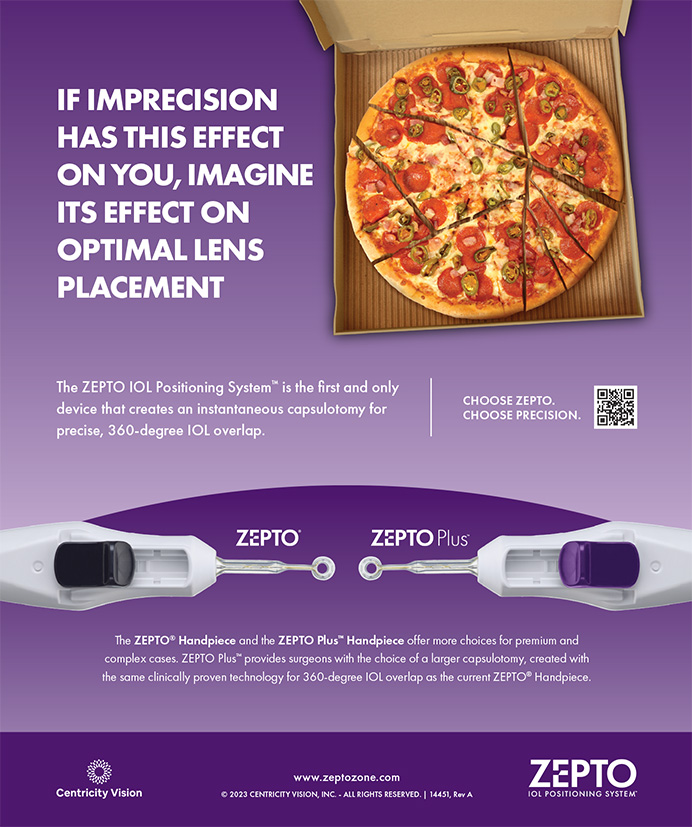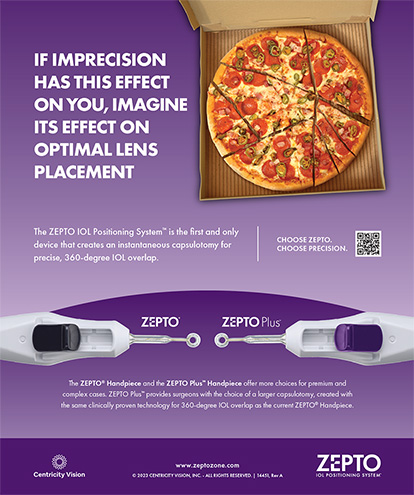What is the state of refractive surgery in France? Refractive surgery is not as popular in France as it is in the US. Last year, approximately 115,000 refractive surgery procedures were performed: 75,000 LASIK (there were 225,000 in Spain), 35,000 PRK/LASEK, and 5,000 phakic IOL implants. Currently, 130 sites have fixed lasers, and 60 sites have mobile rental lasers.1 French culture still depends heavily on spectacles. Contact lens wearers number only 3 million in a population of 60 million. Although, several models of anterior-chamber, iris-fixated, and posterior-chamber phakic IOLs are readily available, the volume of implants remains low. In France, 35% of refractive surgeons perform clear lensectomies.1 Clear lens replacement for the treatment of presbyopia is gradually gaining acceptance.
What are your current thoughts on the roles of clear lens exchange and prophylactic peripheral retinal laser photocoagulation in high myopes? In 1999, colleagues and I published the results of a prospective series of clear lensectomies in patients with high myopia over a 7-year period.2 The incidence of retinal detachment (RD) in these eyes exceeded its incidence in unoperated myopic eyes by 0.68%. The PMMA posterior chamber lens implant required a large limbal incision, however, leading to the high rate of posterior capsular opacification, which may influence the occurrence of RD. My observation is that the incidence of RD is now even lower with less invasive procedures and foldable IOLs. Peripheral retinal photocoagulation is not validated, and it can cause vitreoretinal proliferation if RD occurs. In turn, RD can be more severe if a retinal tear occurs posterior to coagulation. Nevertheless, with less vitreoretinal pathology and a lower risk of RD, clear lens exchange for hyperopia is considered safe and effective, except in eyes with extreme hyperopia. I also recommend screening out individuals whose occupations involve frequent nighttime driving.
What are your thoughts on using corneal ring segments for keratectasia and on virgin keratoconics versus iatrogenic ectasias after LASIK? When evaluating Intacs, I immediately checked the flattening of the central cornea by rings in ectatic corneas. In virgin keratoconus, the implantation of two segments improved vision in approximately 80% of eyes.3 We have not yet decided on the best nomogram to determine ring location and thickness. The dissection of stromal channels with a femtosecond laser improves the surgery's safety and accuracy. In corneal ectasia after LASIK, corneal rings produce similarly good results. In such cases, single inferior segment implantation is effective.
Who influenced you during your training as a refractive surgeon? In the early days of RK and keratomileusis, results were not always reliable. I visited Perry Binder, MD, of San Diego and was impressed by his scientific and honest approach to refractive surgery, so I invited him to perform live surgery demonstrations in my hospital. Since then, he has continued to be my mentor.
Where do you see refractive surgery in the next 5 to 10 years? Economic patterns and increasing patient reliability point toward surgical volume growth in France and worldwide. All LASIK procedures will eventually be standardized. Laser intrastromal ablation without a flap cut may be safer if its predictability can be demonstrated. There is a bright future for the phakic IOL as an accurate and stable technology that respects the central corneal architecture without requiring variability of the individual tissue healing process. The best design and intraocular location still need to be determined. The treatment of presbyopia will be the major challenge for refractive surgeons. Existing techniques provide suboptimal compromise for distance and near vision.
1. Gold R. Practice styles and preferences of French cataract and refractive surgeons. Paper presented at: XXI Congress of the ESCRS; September 8, 2003; Munich, Germany.2. Colin J, Robinet A, Cochener B. Retinal detachment after clear lens extraction for high myopia: seven-year follow-up. Ophthalmology. 1999;106:2281-2285.
3. Colin J, Simonpoli-Velou S. Managing keratoconus with Intacs. Cataract & Refractive Surgery Today. 2003;5:36-40.


